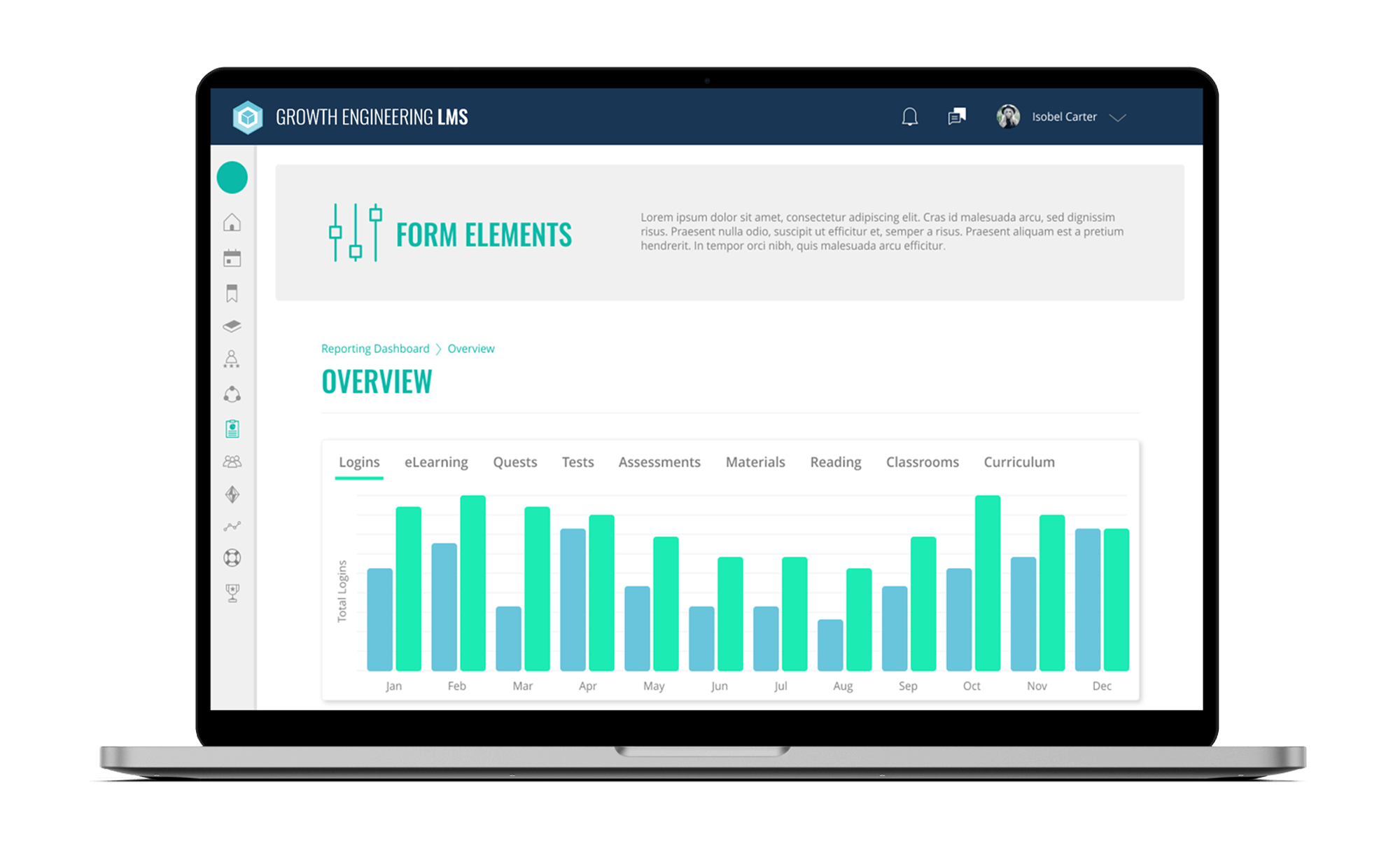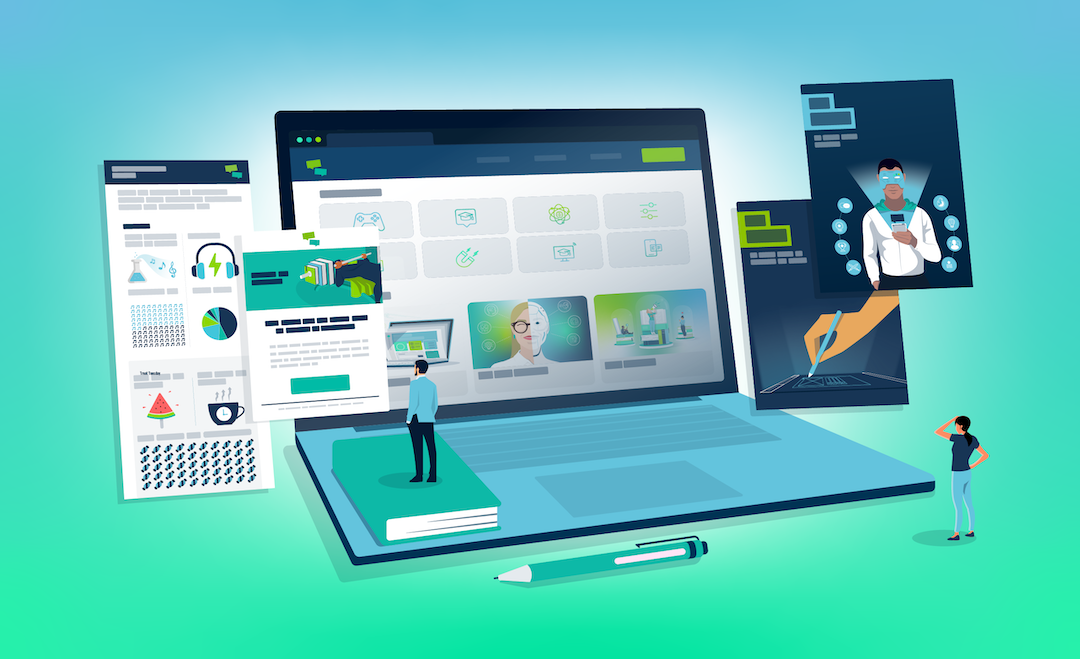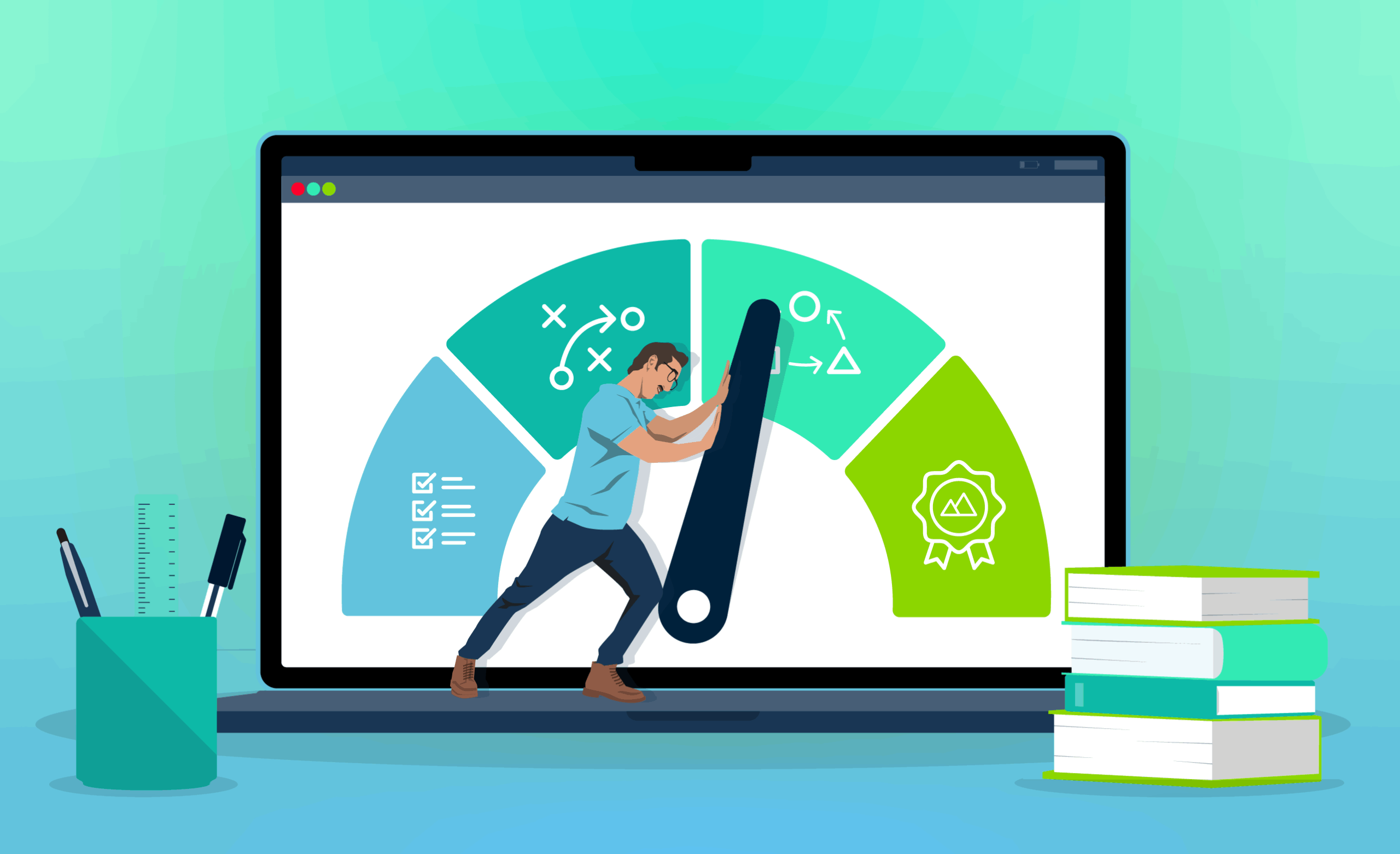 Learning and feedback go hand-in-hand. They form a symbiotic relationship, with each reinforcing and facilitating the other. After all, feedback guides, motivates and regulates learning.
Learning and feedback go hand-in-hand. They form a symbiotic relationship, with each reinforcing and facilitating the other. After all, feedback guides, motivates and regulates learning.
Imagine a world without feedback. Every action would be wrought with uncertainty. Innovation would stop, accountability would erode and communication would falter. Any growth that took place would effectively do so by accident.
Your learners will feel this same crushing sense of uncertainty if you fail to provide effective feedback throughout their learning journey.
Whilst constructive criticism can sometimes be difficult to stomach, it’s also how we grow and improve. As business consultant Ken Blanchard puts it, ‘feedback is the breakfast of champions’.
Delivering feedback to your learners shows that you care. It demonstrates that you have a vested interest in your learners’ growth, improvement and overall success. This kind of personalised attention is exactly what cultivates safe and supportive learning cultures.
Over the course of this article, we’ll explore what good learner feedback looks like, where it comes from, how it helps and how you can incorporate it within your learning environment.
When we reach the end you can let us know how we’ve done. Let’s get started!
What is Feedback?
Feedback is a powerful communication tool. It’s a process by which information is shared that helps individuals or groups to understand how well they are performing. This typically includes actionable suggestions that the subject may choose to adopt.
In other words, feedback helps us to understand what we’re doing right, what we’re doing wrong and how we can improve. As such, it can be useful in a variety of contexts. For instance:
- Decision making: When we’re forced to make a tough choice, feedback can provide valuable data and insights and that leads to better outcomes.
- Interpersonal relationships: Muddling through social situations can be a complex process. Feedback can often lead to better communication and less conflict.
- Athletics: Most professional athletes have a coach. They are there to provide tailored suggestions that improve performance.
- Creative arts: Whether you’re a writer, musician or a visual artist, feedback can be useful. The right piece of advice can lead to major breakthroughs.
And so on. The list is more or less endless. Of course, feedback is also useful in the world of education, personal development and structured workplace learning. That’s what we’ll look at in the next section.
Feedback is a force for good in the workplace. But, it’s also important to recognise that it can have a negative impact if it’s delivered poorly or ineffectively. In fact, ill considered feedback can lead to anxiety, esteem issues, resistance and demotivation.
But don’t fret! We’ll explore what good feedback looks like later in this article.

What’s Learner Feedback?
Now we know what feedback is in a general sense, it’s easy to see how this might apply to the world of learning.
In this context, feedback is information that is shared with learners during an educational process that helps them to understand their performance, identify areas for improvement and make adjustments.
When feedback is used effectively, it always enhances a learning experience. As a result, it can help to promote skill acquisition, improve performance, change behaviour and lead to better business outcomes.
Where does this Feedback Come From?
Learner feedback sounds great, doesn’t it? Unfortunately, it doesn’t grow on trees. It needs to be cultivated.
Providing tailored feedback for each learner in your audience may sound like an impossible task. But, you have to remember that you are not alone. Feedback can come from a variety of different sources:
Instructors: Your instructors and trainers play a key role in the learning process. They’ll observe your learners, ask questions and set assignments designed to assess their performance. Following this, they’ll be in a position to provide guidance and suggestions where relevant.
Managers: In an organisational structure, each learner will typically have a manager that they report into. Given their proximity and the nature of their relationship, this manager is well placed to provide feedback and suggestions to your learners. For instance, they may be able to recommend topics for each learner to focus on.
Coaches: Some of your learners may have access to coaches or mentors. They are there to help your learners to develop and reach their full potential. This usually involves one-to-one conversations that provide an opportunity for evaluation, feedback and reflection.
Peers: Don’t forget, your learners can also learn from each other. This is useful, as they will often have similar needs, interests and perspectives. This can lead to more empathetic and meaningful feedback experiences. As such, peer-to-peer feedback is a vital part of any collaborative learning process.
Self-Assessment: Learners can also assess their own performance. After all, reflecting on your strengths, weaknesses and overall progress is a form of feedback. It’s often useful to provide your learners with tools (such as workbooks or self-evaluation forms) to help guide this process.
Automated Feedback: Tools such as quizzes, polls and assessments can be used to automate the feedback process. This provides learners with immediate feedback, based on how many questions they answer correctly. It’s also an opportunity for you to offer question-specific input and further learning interventions.
And that’s just the start. In reality, your learners will be receiving feedback from a huge variety of sources. This could include clients, partners, family, friends, supervisors, advisors, experts and so on.
As we’ll see, much of this feedback can be delivered or facilitated through learning technology.
What Does Research Tell Us?
Intuitively, feedback seems like a good thing. But what does the research tell us?
- 89% of HR leaders agree that peer-to-peer feedback and regular check-ins help to drive successful business outcomes.
- 57% of employees want corrective feedback rather than praise and recognition.
- 92% of those surveyed agree that constructive feedback leads to performance improvements.
- 85% of employees believe they take more initiative and responsibility as a result of feedback in the workplace.
- Organisations that share feedback with their employees have a 14.9% lower turnover rate than those that don’t.
- Employees who regularly receive recognition and feedback at work are 84% more likely to be thriving.
Whilst most of these statistics refer to on-the-job feedback, it’s easy to see how they could carry over into the world of learning and development.
A Need for Speed
When it comes to feedback, speed matters. After all, the timeliness of your recommendations can affect your learners’ performance, motivation and ability to make informed decisions.
In fact, studies show that participants who receive immediate feedback perform significantly better than those who receive delayed feedback.
Sluggish feedback can be just as bad as no feedback at all. If your learners are awaiting your input, then there’s no opportunity to correct any misconceptions or errors. This can lead to mistakes or missed opportunities, particularly in time-sensitive situations.
Delayed input can also generate learner uncertainty. After all, your learners are effectively living in limbo until they’ve heard from you. This can create anxiety and may even demotivate your audience.
As Gallup notes, ‘Fast Feedback’ helps to support agility, inspire excellence and retain talent. They suggest that feedback should be ‘frequently and effectively’ exchanged.
Embracing Instant Feedback
 The quickest kind of feedback is instant feedback. This relates to information, recommendations and suggestions that are generated immediately when learners complete specific tasks.
The quickest kind of feedback is instant feedback. This relates to information, recommendations and suggestions that are generated immediately when learners complete specific tasks.
For instance, upon completing a quiz, learners should receive feedback in the form of an overall score, grade, pass or fail details and further information relating to each question.
As none of this information requires manual intervention, it can and should be served to your audience instantly. As a result, your learners will be able to pause, reflect and modify their approach in the moment.
What’s more, if you’re providing feedback in the flow of learning, then your learners will always know that they’re on the right track. This removes doubt and promotes autonomy.
That’s why we use gamified achievements on Growth Engineering LMS to reward learners for certain activities on the platform. This can include, for instance, sharing a social post, rating content or downloading a training unit.
What is a Feedback Loop?
Ultimately, instant feedback leads to a more efficient and effective feedback loop.
This is a cyclical process where the outcome of an event or action is assessed and then used to inform future decisions. Feedback loops are typically used in machines, circuits, coding, economic processes and so on.
When it comes to learning, it may be easier to think of your brain as a system designed to deal with inputs and outputs. A feedback loop occurs when the brain uses an output (for instance, sensory data) as an input for future operations.

Put another way, a learner might notice, ‘when I complete an eLearning unit, I earn a virtual Badge’. Receiving this Badge is a form of feedback. It shows the learner that they are on the right track. The learner might then test their hypothesis, creating a loop.
As cognitive scientist Tom Stafford puts it, ‘thanks to feedback we can become more than simple programs with simple reflexes. [It] allows animals like us to follow a purpose.’
This shows us why quick or immediate feedback is important. The sooner your learners receive outputs, the quicker they’ll be able to use that information as an input during future activities. This helps them to close the loop and build momentum.
What Does Good Feedback Look Like?
Now we know what feedback is and why it’s important that it’s delivered contextually and at the speed of need. But what other characteristics define good feedback?
Specificity: Vagueness, ambiguity and generalisation are the enemies of good feedback. Wherever possible, you should address particular aspects of performance, use evidence and provide concrete examples. More detail means better data for your learners to input into their feedback loops.
Constructive: Delivering constructive feedback isn’t easy. In fact, 44% of managers find sharing constructive feedback difficult. Remember, you’re providing feedback on a learner’s performance, not their personality. As such, don’t just focus on their strengths. You also need to outline opportunities for improvement.
Actionable: Constructive feedback should also be directive. Don’t just tell your learners what they’re doing wrong. Show them the pathway to success. Provide actionable suggestions or recommendations that will help them to improve. That way they will come to love your input, rather than fear it.
Consistent: You should ensure that the feedback you provide is consistent. This helps to promote a sense of objectivity in the feedback process, which also enhances your credibility. Ultimately, this ensures that each individual learner is treated fairly and equitably.
Supportive: Remember, the ultimate goal of your feedback is to help your learners to grow and improve. With this in mind, you should deliver feedback respectfully and with empathy. In fact, if you fail to do so, you may even demoralise or discourage your learners.
Two-way Feedback
Feedback is not a one way street. A healthy organisational learning culture should boast an effective two-way feedback system. In other words, you should provide feedback to your learners and your learners should provide feedback to you.
Indeed, according to Dr David Rock (the mastermind behind The SCARF Model), ‘by switching from giving feedback to asking for it, organisations can tilt their culture towards continuous improvement’.
Your learners are at the proverbial coalface. As a result, they have valuable insights to share. Their feedback can help you to refine your learning strategy, enhance your learning environment and improve your decision making.
As such, you should seek to facilitate an open dialogue between you and your learners. This can be achieved through the use of surveys, happy sheets, focus groups, check-ins or online platforms.
Creating this open dialogue helps to empower your learners. In fact, employees are 4.6x more likely to perform better if they feel like their voice is being heard. As a result, you’ll create a more learner-centric environment and drive better educational outcomes.
Feedback & Technology
 Digital learning solutions, such as learning management systems, have made it considerably easier to share feedback with your learners. Indeed, studies show that feedback delivered by digital technology leads to positive outcomes.
Digital learning solutions, such as learning management systems, have made it considerably easier to share feedback with your learners. Indeed, studies show that feedback delivered by digital technology leads to positive outcomes.
After all, platforms like Growth Engineering LMS offer features that help learners to track their progress and communicate with instructors. It can also automatically grade assignments and quizzes providing instant feedback for learners.
Game mechanics such as XP, Badges and Leaderboards can also be used to provide feedback within a digital learning environment. Your learners can also access discussion forums and social clubs to seek out suggestions from their peers.
This helps educators to save time and ensures that learners receive timely insights into their performance.
Final Words
In the world of education and organisational learning, feedback is a guiding light. Without it learners would be left in the dark. But with it, learners know where they stand, where they’re heading and what they need to do to get there.
However, we’ve also seen that the quality of your feedback matters. A simple, ‘great job!’ or ‘not quite there yet’ is insufficient. To truly motivate your learners you’ll need to provide feedback that’s specific, constructive, actionable and supportive.
Your input also needs to be timely. If you can achieve this, then your learners will close their feedback loops quicker and start improving their performance. And isn’t that the ultimate goal of any training intervention?
Thank you for reading! Hungry for more learning and development tips? How about 165 of them? Download the ‘L&D Professional’s Handbook’ now.








